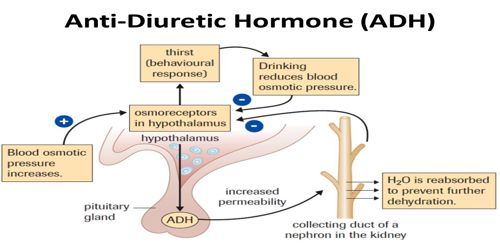Regulation and Function of Antidiuretic Hormone, Vasopressin Function and MCQ for NEET, GPAT, UPSC, CSIR NET,GATE
Antidiuretic Hormone (ADH)
ADH is release from Posterior Pituitary.
Function of Antidiuretic Hormone
As its name implies, an antidiuretic (anti- = against; dia = throughout; uresis = urination) is a
substance that decreases urine production.
ADH causes the kidneys to return more water to the blood, thus decreasing urine volume. In the absence of ADH, urine output increases more
than tenfold, from the normal 1 to 2 liters to about 20 liters a day. Drinking alcohol often causes frequent and copious urination because alcohol inhibits secretion of ADH. ADH also decreases the water lost through sweating and causes constriction of arterioles, which increases blood pressure. This hormone’s
other name, vasopressin, reflects this effect on blood pressure. The amount of ADH secreted varies with blood osmotic pressure and blood volume.
Regulation of ADH secretion and the actions of ADH
●1 High blood osmotic pressure—due to dehydration or a decline in blood volume because of hemorrhage, diarrhea, or excessive sweating—stimulates osmoreceptors, neurons
in the hypothalamus that monitor blood osmotic pressure. Elevated blood osmotic pressure activates the osmoreceptors directly; they also receive excitatory input from other brain areas when blood volume decreases.
●2 Osmoreceptors activate the hypothalamic neurosecretory cells that synthesize and release ADH.
●3 When neurosecretory cells receive excitatory input from the osmoreceptors, they generate nerve impulses that cause exocytosis of ADH-containing vesicles from their axon terminals in the posterior pituitary. This liberates ADH, which diffuses into blood capillaries of the posterior pituitary.

●4 The blood carries ADH to three target tissues: the kidneys, sudoriferous (sweat) glands, and smooth muscle in blood vessel walls. The kidneys respond by retaining
more water, which decreases urine output. Secretory activity of sweat glands decreases, which lowers the rate of water loss by perspiration from the skin. Smooth muscle in the walls of arterioles (small arteries) contracts in response to high levels of ADH, which constricts (narrows) the lumen of these blood vessels and increases
blood pressure.
●5 Low osmotic pressure of blood (or increased blood volume) inhibits the osmoreceptors.

●6 Inhibition of osmoreceptors reduces or stops ADH secretion. The kidneys then retain less water by forming a larger volume of urine, secretory activity of sweat glands
increases, and arterioles dilate. The blood volume and osmotic pressure of body fluids return to normal
Other condition which Alter ADH secretion
Secretion of ADH can also be altered in other ways. Pain, stress, trauma, anxiety, acetylcholine, nicotine, and drugs such as morphine, tranquilizers, and some anesthetics stimulate.
ADH secretion. The dehydrating effect of alcohol, which has already been mentioned, may cause both the thirst and the headache typical of a hangover.

Disease Related to ADH secretion
Hyposecretion of ADH or nonfunctional ADH receptors causes diabetes insipidus
Other Articles where you find MCQ and Other information of ADH and other Endocrine hormones = Click On Below links
Disorders of Endocrine Glands and MCQs For NEET, GPAT, Pharmacist, Staff Nurse Exam
Pituitary gland, Hypothalamus and Their Hormone and Multiple choice question for NEET, AIIMS, GPAT
Urine formation and MCQs for NEET Exam, Pharmacist, GPAT, Nursing Exam , SSC Exam